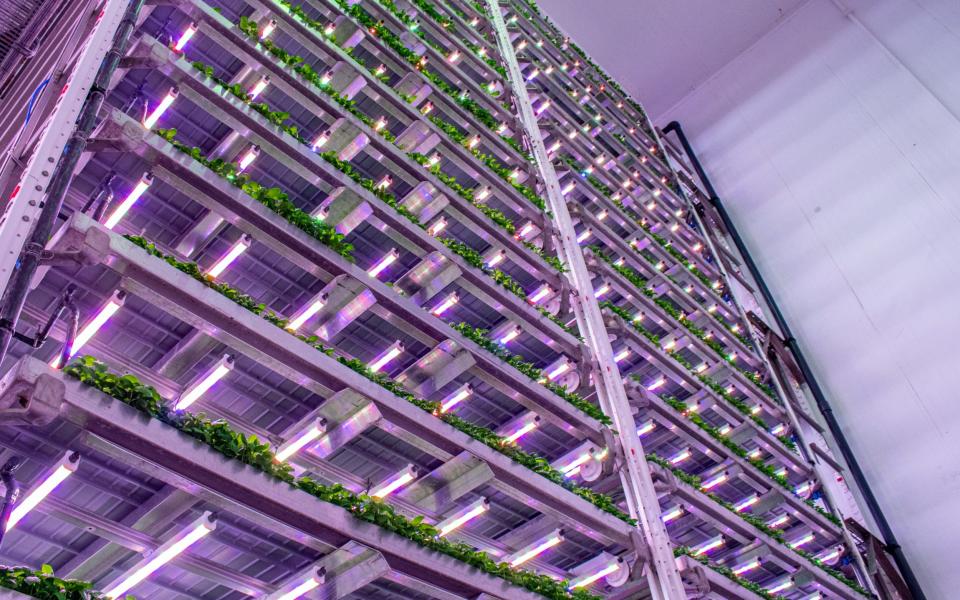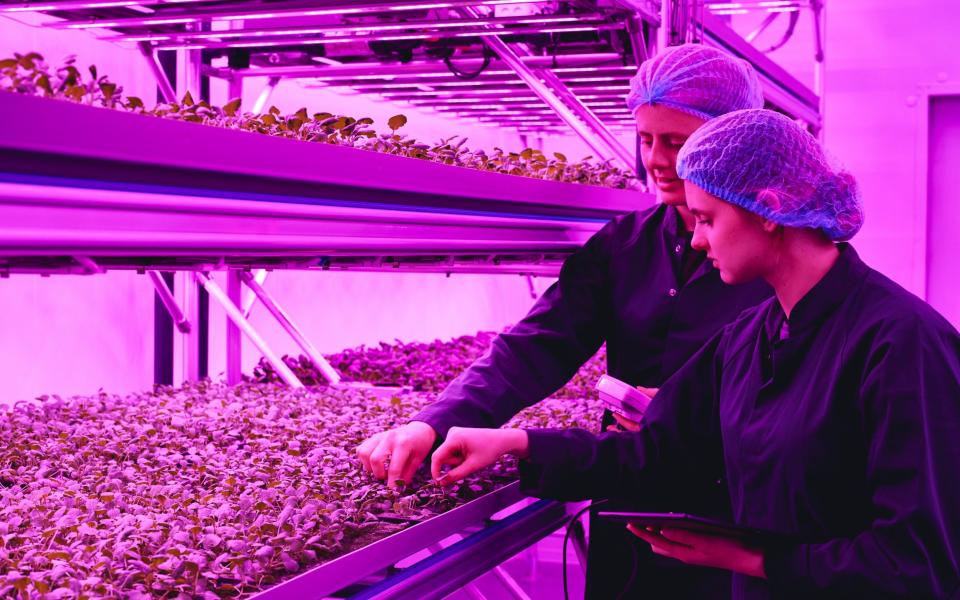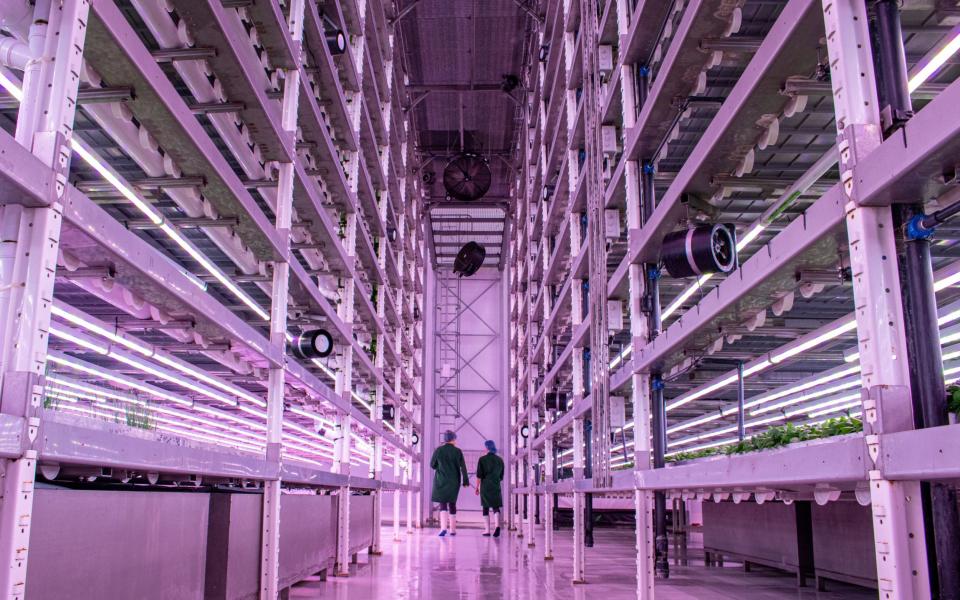The futuristic farming technique that could solve our food crisis

It’s a farm, but not as you know it. There is no soil. There are no tractors, silos or rolling fields. Instead, on a former brownfield site near Sandwich, Kent, there is a warehouse, signposted GrowUp. Step inside, and you’ll find 12 layers of carefully temperature-controlled crops bathed in bright pink LED light – the equivalent of 1,000 acres of farmland, stacked floor to ceiling.
And Kate Hofman, GrowUp’s co-founder, isn’t actually a farmer. She’s a former management consultant who left a “comfortable, corporate” job at IBM in 2013 to invest her time in a burgeoning industry: vertical farming.
The pressure to feed a growing population has never been greater. The invasion of Ukraine and cost of living crisis has put British food security under the spotlight. At this point in the year, about 90 per cent of the salad usually available in supermarkets is imported. And, as anyone who has done a food shop recently will know, there hasn’t been much in the way of leaves available at all.
But a new generation of food producers is rising to the challenge. Now, a decade since it was founded, GrowUp has become the first vertical farm in the UK to supply branded salad to supermarkets (you can buy their “Fresh Leaf Co” baby leaves in Iceland).
Instead of ploughed fields, the crops are stacked in neat layers and grown inside, in controlled conditions. This reduces drastically the amount of growing space required and removes the confines of a growing season – crops can be harvested all year round. A sophisticated irrigation system delivers a nutrient mix to the plant’s roots. Finely tuned LED lights act as the sun.

“In a vertical farm,” says Hofman, “we’re providing plants with the perfect conditions they need to grow. If it’s lettuce, that’s a Mediterranean spring day, but every day of the year.
“We’re able to control the growing environment,” she adds. “You can actually tailor the wavelengths that you provide the plants with.” The pink-ish light, she explains, is the spectrum of light those plants need at the stage they’re growing.
“On each of those layers, we can control the conditions: not only the lighting and irrigation but the humidity and the temperature of the air around the crop as well. It means that day in, day out, we’re producing the kind of [crops] you might associate with the height of summer. We harvest every day.”
This promising technology has been extolled as the future of farming. It requires significantly less land and water than conventional methods and can reduce the use of pesticides. It removes the variables of a changing climate. As well as in vast warehouses, it works on a hyper-local scale (Selfridges and some branches of Marks & Spencer already have mini vertical farms for herbs in-store).
“The supply chain has never been under more pressure than it is now – from climate change, from rising distribution costs, labour shortages, impacts of Brexit on imports,” says Hofman. “We need to be building more resilience into our food system in the UK and choosing the right products to do that with.” For growers like Hofman, that means looking up.
It allows food to be produced in places where conventional farming is not possible, so pockets of disused urban space can be utilised to bolster Britain’s food supply. There is also the potential for plant scientists to make crops tastier and more nutritious.
GrowUp has been producing salad leaves and herbs in this way for 10 years. But it faces growing competition. A subterranean vertical farm, Growing Underground, opened in a disused air raid shelter in London in 2015. It supplies Marks & Spencer with “microgreens” such as micro-watercress, sunflower shoots and pea shoots for salads. The plants are grown in wool rather than soil and use 70 per cent less water than conventional farming.

The biggest player in this new type of agriculture is the Jones Food Company, which built Europe’s largest vertical farm in Scunthorpe, Lincolnshire, in 2019. It has 5,000 sq m (53,820 sq ft) of growing space and supplies between 15 and 30 per cent of the UK’s basil. Depending on the crop, its yields can be “60 or 70 times more than a conventional farm per square metre”, says James Lloyd-Jones, the company’s founder. Only six people work on the Scunthorpe farm, as robots and automated systems do most of the heavy lifting. This circumvents another of the issues crippling traditional farmers: labour shortages.
Sensing an opportunity, Ocado bought a majority stake in Jones Food Company in 2019. The company opened an “Innovation Centre” in Bristol last year, where researchers experiment with growing strawberries, leafy greens, other herbs (chives, coriander, parsley and thyme) and cut flowers. Now, Lloyd-Jones is eyeing world dominance with a project three times the size. A new farm, “JFC2”, is under construction in Lydney, Gloucestershire. It is eight weeks from completion and will be the world’s biggest vertical farm: 71 metres long with 15,000 sq m of growing space.
“It’s silly that if you go into any supermarket, fruit and salad is being flown in from Morocco, Spain or Peru. It’s crazy,” says Lloyd-Jones. “We should be using the shocks we’re getting now – and Covid and Brexit – to really get our head around why we keep importing and flying food around the world. Let’s get to the point where we can try and at least displace imports in the next 10 years. We could really lead the world in this type of technology as a country.”
There’s just one problem: man cannot live on cut herbs and “microgreens” alone. This is the main argument of vertical farming’s critics – that it’s not much more than a gimmick to grow garnishes. Could lower-value staples like onions and potatoes be farmed vertically? What about cereal crops like wheat and barley, which take months to grow? “We’ve grown [them], but we’re about 30 years off making that work commercially,” says Lloyd-Jones. “We need a way to make growing them shorter, faster and overall cheaper.”

Some traditional farmers are justifiably sceptical, too. Hofman recently spoke at the Oxford Farming Conference. There were “some preconceptions about what vertical farming meant and what vertical farmers thought,” she says. “We really see what we do as part of the present and the future of farming … The way we talk about food and farming is the way [they] talk about it. Lots of forward-thinking farmers already think about diversification and ways of farming sustainably.”
But it has so far proved impossible to make more substantial fruit and vegetables work on a commercial scale. This is partly due to the energy costs involved: all those pink LEDs and temperature controls require plenty of power. Vertical farmers have been especially vulnerable to energy price increases.
Some have chased rapid expansion and flown too close to the sun. Infarm, a European vertical farming start-up valued at $1 billion (£820 million), made 500 staff (over half the workforce) redundant in November last year. The company had just opened a vast vertical farming facility on the outskirts of Bedford.
In an email to employees, its co-founders said: “In our current setup, we recognise that Infarm cannot withstand the challenging market conditions, particularly with regards to escalating energy prices and tough financial markets … Energy prices have escalated (doubled across Europe), which puts a lot of additional pressure on our business and seriously impacts our cost of production in affected markets.”
The fatal error some people make, says Lloyd-Jones, is to mistake hype for growth: to look at vertical farming in terms of “tech valuations” rather than the “real cost we have to build and grow at”. The potential is huge: “It’s not just food supply … it’s nutraceuticals, pharmaceuticals, it’s taking pressure off the land by growing other commodity crops or letting it rest while our systems do all the other things.”
However, the cost of energy will continue to be an issue. There is no way Hofman could have predicted the energy crisis but, luckily, she and GrowUp’s co-founder Tom Webster thought ahead. “We’ve got quite a unique model – we built this farm right next to existing renewable energy infrastructure, so we buy electricity and heat directly from the power plant. That’s one of the major ways we’ve been able to scale the business and keep our production costs affordable.”
There’s no doubt it’s a “challenging industry”, says Hofman. But she’s not saying vertical farming is the only way forward. To the critics: “We’re firmly of the view that not all food will be grown in vertical farms. That’s not the point of what we’re trying to do. Vertical farming is a necessary part of a robust and resilient food system. And that’s got to include lots of different kinds of food production.”
Plus, it’s a nascent industry. “I think it’s important to remember that vertical farming is still at a fairly early stage – a lot of people are still working out where they fit,” says Hofman. So, what’s next? GrowUp is looking at reintroducing heritage seed varieties that can no longer be grown in fields, as well as other “fruit plants and salad vegetables”. They also hope to replicate their renewable energy model across more vertical farm sites.
“There’s some really exciting things that we’re doing from a research perspective that I hope will [mean] that in five to 19 years we can tackle more challenging crops,” says Hofman. You could say the sky’s the limit.

 Yahoo News
Yahoo News 
